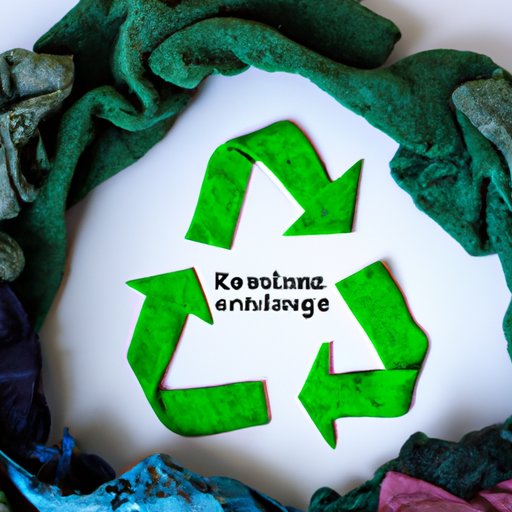Introduction
Clothes recycling is the process of collecting and reusing old clothing, fabrics and textiles. It involves sorting and processing used clothing, which can then be donated to charities or sold in second-hand stores. Clothes recycling helps reduce the amount of clothing waste that ends up in landfills and reduces the environmental impacts associated with the production, use and disposal of clothing materials.
This article will explore the benefits of clothes recycling and investigate different ways clothes can be recycled. We will also examine the environmental impact of clothing waste and understand the process of donating and recycling used clothing. Finally, we will look at innovative solutions for reducing clothing waste and examine the role of the fashion industry in clothing recycling.
How to Recycle Your Clothes Responsibly
When it comes to recycling clothes, there are a few different options available. The most common way to recycle clothes is to donate them to charity. Donating your old clothes is a great way to help those in need while also reducing the amount of clothing waste that ends up in landfills. You can find local charities that accept donations by searching online or asking around in your community.
Another option is to sell your used clothing in a second-hand store or online marketplace. This is a great way to make some extra money and keep your old clothes out of landfills. You can also try to repurpose or upcycle your old clothes into something new. This can be done by sewing, cutting, dyeing or painting your old clothes to create something unique and one-of-a-kind.

Investigating Different Ways Clothes Can Be Recycled
The process of clothes recycling involves several different steps. Textile recycling is a process wherein unwanted or damaged textiles are collected, sorted and processed into new materials. These materials can then be used to create new products such as insulation, carpet padding and stuffing for pillows and furniture.
Fabric recycling is another form of clothes recycling. This involves collecting and reusing fabrics from old clothing to create new garments or other items such as rugs, bags or blankets. Shoes and accessories can also be recycled by breaking them down into their component parts and using the materials to make new products.

Examining the Impact of Clothing Waste on the Environment
Clothing waste has an immense impact on the environment. When clothing is thrown away, it often ends up in landfills where it takes years to decompose. This contributes to air and water pollution, as well as the release of methane gas, which is a major contributor to global warming.
The production of clothing also has a significant carbon footprint. This includes the energy and resources required to produce the raw materials, manufacture the garments and transport them to retailers. Additionally, the use and disposal of clothing also contributes to the emission of greenhouse gases.
Understanding the Process of Donating and Recycling Used Clothing
When you donate your used clothing, it goes through a sorting process. All clothing is inspected and sorted based on quality, size and condition. After it is sorted, the clothing is either sold in second-hand stores or donated to charities. The proceeds from the sale of used clothing are then used to fund charitable programs.
Recycling used clothing involves breaking down the materials into their component parts. These parts are then reused to create new products such as insulation, carpet padding and stuffing for pillows and furniture. The recycled materials can also be used to make new clothing.

Exploring Innovative Solutions for Reducing Clothing Waste
Sustainable textiles are one of the most promising solutions for reducing clothing waste. Sustainable textiles are made from materials that are produced in an environmentally responsible manner, such as organic cotton and bamboo fibers. These materials are designed to be biodegradable, so they can be broken down without creating any additional waste.
Creative upcycling is another way to reduce clothing waste. Upcycling involves taking an existing item and transforming it into something new and useful. This could involve sewing, cutting, dyeing or painting your old clothes to create something unique and one-of-a-kind.
Examining the Role of the Fashion Industry in Clothing Recycling
The fashion industry is beginning to recognize the importance of clothing recycling and is starting to take steps towards becoming more sustainable. Design for disassembly is one approach that focuses on designing garments that can be taken apart and reused or recycled. This means that instead of throwing away a garment when it’s worn out, it can be taken apart and the materials used to create something else.
The circular economy is another approach that focuses on keeping materials in use for as long as possible. This involves creating products that can be repaired, reused, resold or recycled. By adopting these approaches, the fashion industry can reduce its environmental impact and create more sustainable products.
Conclusion
Clothes recycling is an important part of reducing clothing waste and helping to protect the environment. Donating your used clothing to charity or selling it in a second-hand store is a great way to keep your old clothes out of landfills. Additionally, textile and fabric recycling can help reduce the environmental impacts associated with the production, use and disposal of clothing materials.
Innovative solutions such as sustainable textiles and creative upcycling can also help reduce clothing waste. Finally, the fashion industry is beginning to recognize the importance of clothing recycling and is starting to take steps towards becoming more sustainable.
By understanding the benefits and impacts of clothing waste, we can all do our part to reduce our environmental footprint and help protect the planet.


